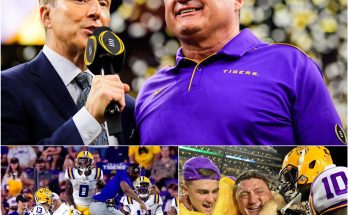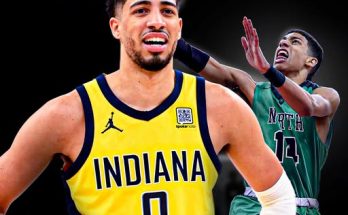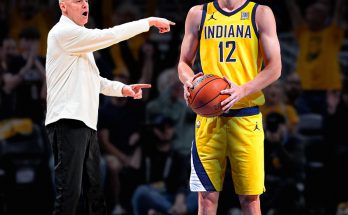John Mateer’s Stellar Spring Silences Doubts as Brent Venables Steps Out of Jackson Arnold’s Shadow and Begins a New Chapter.
For much of the past year, all eyes in Norman were fixed on one name: Jackson Arnold. The former five-star quarterback recruit was supposed to be the future, the savior of Oklahoma football in the post-Caleb Williams era. Arnold’s talent, arm strength, and mobility sparked endless debates about when—not if—he would take over the starting role and elevate Brent Venables’ program to the elite level fans expected. But as spring football arrived in 2025, something unexpected happened. A quiet, composed competitor named John Mateer began to emerge—not as a placeholder, not as a backup, but as a genuine leader. And with each snap, throw, and touchdown drive, he began rewriting the script that had long been written in Norman.
Mateer’s rise didn’t come with fireworks or flashy headlines. He wasn’t the blue-chip prospect with a parade of accolades trailing behind him. What he was, however, was consistent, poised, and determined to prove that he belonged. In the early days of spring practice, while most media attention was still centered on Arnold’s development, those within the program noticed something different about Mateer. He was sharper in his reads, more accurate with his ball placement, and seemingly more confident than ever before. That confidence translated into execution, and soon, Venables and offensive coordinator Seth Littrell had no choice but to take serious note.
What made Mateer’s spring so compelling wasn’t just his on-field efficiency; it was his ability to rally a locker room that had been split between expectations and reality. Arnold, while immensely talented, had shown inconsistency in live-game situations late last season. His raw potential was evident, but so were the growing pains that come with inexperience. Mateer, meanwhile, had been waiting quietly, learning the system, absorbing the speed of the college game, and staying ready for his moment. When that moment arrived this spring, he didn’t hesitate.
In scrimmages and team drills, Mateer displayed command of the offense. He made smart checks at the line, spread the ball to all areas of the field, and showed a willingness to take what the defense gave him. While Arnold often looked to make the big play, sometimes at the cost of a drive’s rhythm, Mateer excelled in building long, sustained series that wore down the defense and maximized time of possession. He wasn’t flashy, but he was effective—and that effectiveness began turning heads.
Perhaps most importantly, Mateer earned the trust of his teammates. Offensive linemen praised his leadership and cadence. Receivers appreciated his timing and anticipation. Running backs noted his communication and ability to adjust plays to their strengths. Slowly, a shift began to occur within the team: Mateer wasn’t just “the other quarterback” anymore. He was becoming the quarterback.
For Brent Venables, the evolution of Mateer brought both relief and validation. As a defensive-minded coach, Venables knows the importance of a quarterback who won’t put his defense in bad positions. Turnovers kill momentum, and last season’s struggles often stemmed from sudden changes that left Oklahoma’s defense gasping for breath. Mateer’s efficiency meant fewer mistakes, better field position, and more controlled tempo. That’s the kind of football Venables wants to play.
More symbolically, however, Mateer’s ascendance gave Venables something else—space to breathe. Since arriving in Norman, Venables has walked in the shadow of his offensive predecessors. Lincoln Riley’s quarterback-driven system, highlighted by Heisman winners like Baker Mayfield and Kyler Murray, set an almost impossible standard. Every offensive decision Venables made was scrutinized under the lens of “What would Riley do?” Jackson Arnold, with his pedigree and hype, was supposed to continue that lineage. When that narrative started to feel forced, Venables found his escape not in pushing against it, but in pivoting quietly with Mateer at the helm.
This spring, Venables looked more in control. No longer was he trying to retrofit a scheme around a quarterback expected to win awards; instead, he was building a team around a quarterback committed to winning games. The difference was subtle but powerful. It showed in the way Venables approached practice—in the tempo, the tone, the attention to detail. He wasn’t babysitting a young star anymore; he was coaching a quarterback who had earned his spot the hard way.
None of this is to say Jackson Arnold’s story is over. The redshirt freshman remains one of the most physically gifted quarterbacks in the country. His deep ball is elite. His mobility is a weapon. And his ceiling, if everything clicks, is still incredibly high. But the spring belonged to Mateer, and it’s hard to deny that the team followed his lead. In scrimmages, Mateer threw with purpose. His touchdown-to-interception ratio was impressive. His timing with receivers like Andrel Anthony, Nic Anderson, and Jaquaize Pettaway was near-perfect. And perhaps most telling, the offense looked the most cohesive when Mateer was under center.
There’s a quiet strength in Mateer that sets him apart. He doesn’t speak in soundbites. He doesn’t chase headlines. He prepares. He competes. He delivers. That simplicity, in a college football world saturated with NIL buzz, social media branding, and transfer portal drama, has become refreshing. Teammates gravitate toward it. Coaches trust it. And fans—initially unsure—are starting to appreciate it.
For Oklahoma’s offense, this spring wasn’t about finding the next Heisman contender. It was about finding a quarterback who could move the chains, finish drives, and put the team in position to win. That’s exactly what Mateer provided. His connection with Littrell’s play-calling grew each week. They found a rhythm—Mateer executing short passes, extending plays when necessary, and maximizing every possession. His red-zone efficiency was particularly notable, turning trips inside the 20 into touchdowns instead of field goals.
There were moments that captured just how far Mateer had come. In one scrimmage, facing a blitz-heavy look from the defense, he calmly adjusted the protection, hit his hot route, and picked up 17 yards on third-and-long. In another, he read a disguised zone coverage, waited an extra half-second, and delivered a back-shoulder strike in tight coverage. Plays like that—subtle but crucial—began stacking up, painting the picture of a quarterback who didn’t need fireworks to be special.
The ripple effects extended beyond the quarterback room. With Mateer in control, the offensive line looked more cohesive. The running backs, led by Gavin Sawchuk and Jovantae Barnes, operated with more space and tempo. The entire offense felt less rushed, more balanced, and ultimately more dangerous.
Defensively, the improvement was welcomed. Venables’ units thrive when they aren’t constantly asked to bail out turnovers or play uphill. A mistake-free offense meant the defense could stay aggressive, rather than reactive. Players like Danny Stutsman and Peyton Bowen praised Mateer’s poise, noting that it forced them to bring their best every practice.
Recruiting-wise, Mateer’s rise also sent a message to prospects: stars matter, but so does development. Oklahoma isn’t just a place where five-stars shine; it’s a place where hard work is rewarded. That message, subtle as it may be, matters in today’s college football climate. It builds trust. It builds culture. It builds teams.
As summer arrives and fall camp looms, the quarterback competition isn’t officially over. Arnold will continue to push. He’ll learn, grow, and improve. But Mateer has set the tone, and the job, for now, is his to lose. His spring wasn’t just a collection of good practices—it was a statement. A statement that he’s ready. That the team is ready. And that Brent Venables, now with a steady hand at quarterback, is ready to turn the page on past expectations and write something new.
The excitement surrounding Mateer isn’t built on hype—it’s built on performance. Every throw, every decision, every practice rep added up to a spring that silenced critics, energized the program, and gave Oklahoma a new identity heading into the 2025 season. It’s not the story anyone expected, but it might just be the story the Sooners needed.



